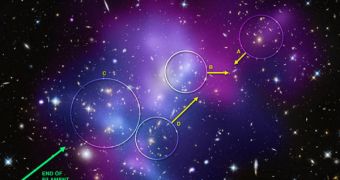For quite some time now, astronomers have known that galaxies are not held together in the Universe by gravity alone, but that they are neatly placed along a scaffolding, which holds them and moves them around. After some time, astrophysicists have inferred that this support structure is also responsible for funneling galaxies into the large cosmic mash-ups known as clusters, through formations known as filaments. But the composition of these filaments has long since remained a subject of controversy in the international astronomical community.
Some have said that the filaments are made up of dark matter and gas, which is in agreement with existing knowledge of the elusive type of matter. And supporters have also added that as much as 40 percent of all existing dark matter in the Universe may be concentrated in these filaments, a theory that could not be proven until now. In order to say for sure that this specific type of matter exists in these cosmic channels, astronomers must first discover the accompanying gas.
The reason why this is so important is because the amount of gas that exists in the filaments may offer researchers a clue as to the amount of dark matter that exists alongside, and a ratio of the two could be determined. This ratio could then be fed in very complex computer models of the filaments, which would in turn predict how large galaxy clusters, as well as other gigantic space structures, are formed over billions of years.
University of Hawaii astronomer Harald Ebeling is quoted by NewScientist as saying that, “It's only logical that the gas and the dark matter trace the same structure, but quantitatively, we do not know whether the simulations and the observations match.” Just recently, Ebeling has managed to infer the first signs of the existence of gas inside filamentary structures in deep space, together with a team of experts led by Cheng-Jiun Ma.
While analyzing the MACSJ0717.5+3745 galaxy cluster, located some 5.4 billion light-years away from our solar system, the astronomers noticed that there seemed to be a very peculiar, filament-like structure channeling countless galaxies in an area already filled with them. “This is the proverbial 800-pound gorilla in space. It's one of the most massive known clusters anywhere, and certainly one of the most messed up I know,” Ebeling adds.
Careful observations of the area where the filament impacted the galaxy cluster, taken in X-ray and optical wavelengths, revealed the fact that large amounts of hot, dense gas existed at the boundary. “We speculate that continuous heating from the filament – with gas flowing in all the time – causes this,” Ebeling argues. “Right now, we're only just barely seeing where it hits the cluster. But as you move away from the cluster, the gas is still unperturbed. This is the pristine, original state of gas in filaments – the holy grail for observational X-ray searches.”
The team have submitted a request for observation time with the Chandra X-ray Telescope, in a move that they hope will allow them to better understand what exactly is going on inside the large cluster.

 14 DAY TRIAL //
14 DAY TRIAL //